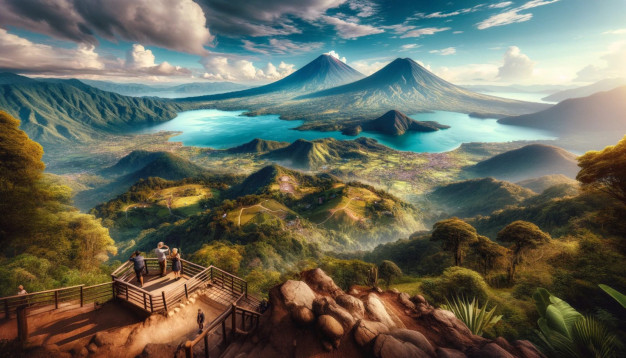Geography of Guatemala
Explore Guatemala's geography: from mountains to coastal areas

Location and Borders
Nestled between Mexico, Belize, Honduras, and El Salvador, Guatemala is Central America’s own heart of geographical diversity, boasting a spread of landscapes that would make even the biggest countries blush. With coasts on the Caribbean Sea and the Pacific Ocean, it offers a passport full of experiences in a relatively compact space.
Topographical Overview
The country’s terrain is a dramatic spectacle, from low-lying coastal plains to highlands that reach for the clouds. It’s as if mother nature used Guatemala as a canvas to showcase her finest work in topography. Not content with flat and boring, the highlands dominate the landscape, and an occasional plateau here and there adds variety to the mix.
Physical Geography
Mountain Ranges and Volcanoes
Guatemala is the land of the Sierra Madre, a mountain range that splits the country like a backbone and home to over 30 volcanoes, ensuring the nation’s profile is more jagged than a broken bottle. Three of these fiery beasts are active; Volcán de Pacaya, Volcán de Fuego, and Volcán Santiaguito have more mood swings than a teenager, providing awe-inspiring displays for both locals and travelers.
Rivers and Lakes
Rivers like the Motagua and the Usumacinta are the country’s lifelines, carving the land and providing essential resources. Then there’s Lake Atitlán, a body of water so picturesque it makes other lakes look like puddles. Ringed by volcanoes, it’s the Central American answer to Italy’s Lake Como, minus the movie stars and paparazzi.
Climate Zones
In Guatemala, the climate zones are like a menu of seasons; you can pick and choose. Want eternal spring? Head to the highlands. Prefer sweating like you’re in a sauna? The tropical rainforests have got you covered. And if you enjoy being pelted by rain for part of the year, the Petén region will oblige with its monsoon-like downpours.
Biodiversity and Natural Environment
Flora
Guatemala’s flora is a botanical bonanza, a country where trees and plants don’t just grow, they throw a non-stop green party. From the rainforests teeming with mahogany and ceiba to the cloud forests that seem to harbor every shade of green imaginable, it’s a plant lover’s paradise with more species than a botanist’s dream.
Fauna
The fauna here is a veritable United Nations of animals. The national bird, the resplendent quetzal, is a flying rainbow. Then you’ve got your jaguars, monkeys, and tapirs, just chilling in the jungles like they own the place. It’s like someone gave the animal kingdom its own country club, and it’s invitation-only.
Human Geography
Population Distribution
Guatemala’s population is like a party where most people huddle in the kitchen; in this case, the kitchen is the fertile highlands and the dynamic southern coast. The sprawling metropolis of Guatemala City holds a sizable chunk of the populace, proving that in the game of urban magnets, size does matter.
Urban vs Rural Areas
Urban areas like Guatemala City and Quetzaltenango are the throbbing hearts of commerce, while rural areas maintain a pace of life that’s as relaxed as a sloth on vacation. In these parts, traditions stick like rice on a pot, and the local markets are more colorful than a box of crayons on steroids.
Economic Regions
Coffee and sugar aren’t just morning pick-me-ups; they’re the caffeinated backbone of Guatemala’s economy. The highlands brew some of the world’s finest coffee beans, while the Pacific coast has cornered the market on sugarcane, proving that sweet teeth and coffee cravings are excellent for business.
Environmental Issues
Deforestation
It’s as if some folks in Guatemala took the saying “can’t see the forest for the trees” too literally and decided there were just too many trees. Rampant deforestation is turning lush forests into barren landscapes, and the local woodpeckers are starting to wonder if they need to find a new line of work.
Water Pollution
Some of the waterways have more chemicals than a high school science lab, thanks to industrial waste and agricultural runoff. Fish are starting to think they’re in a year-round science experiment, and not the fun kind with volcano baking soda eruptions.
Climate Change Impacts
Climate change is the uninvited guest that just won’t leave, exacerbating weather extremes from droughts to severe storms. Guatemala’s already sensitive ecosystems are left walking the tightrope, and the locals are forced to adapt to a climate that can’t decide if it’s coming or going.